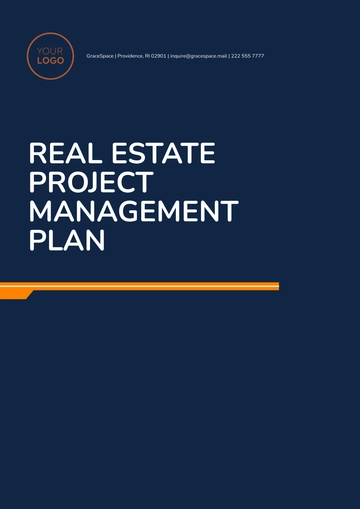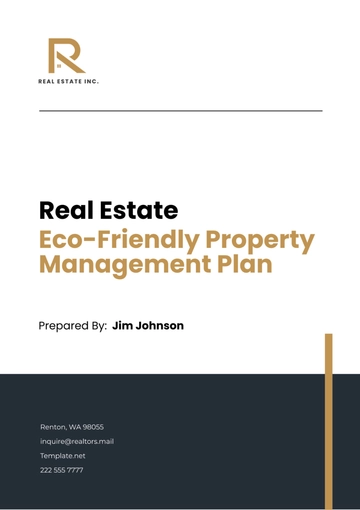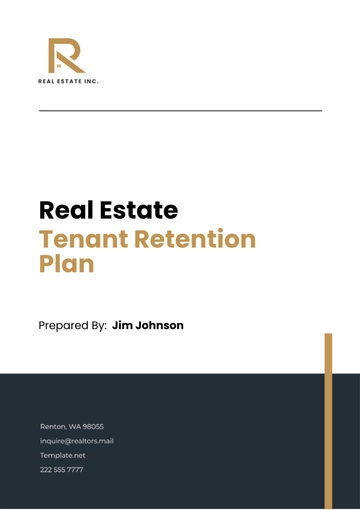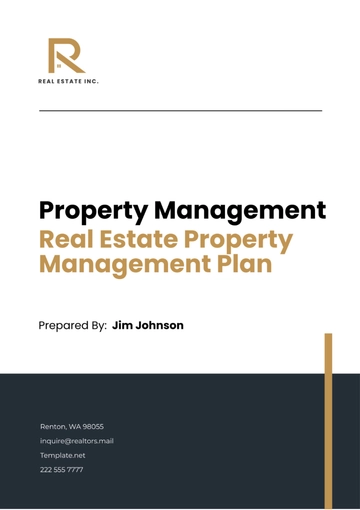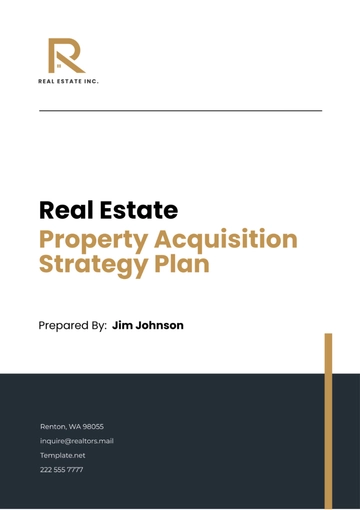Free Real Estate Property Acquisition Strategy Plan
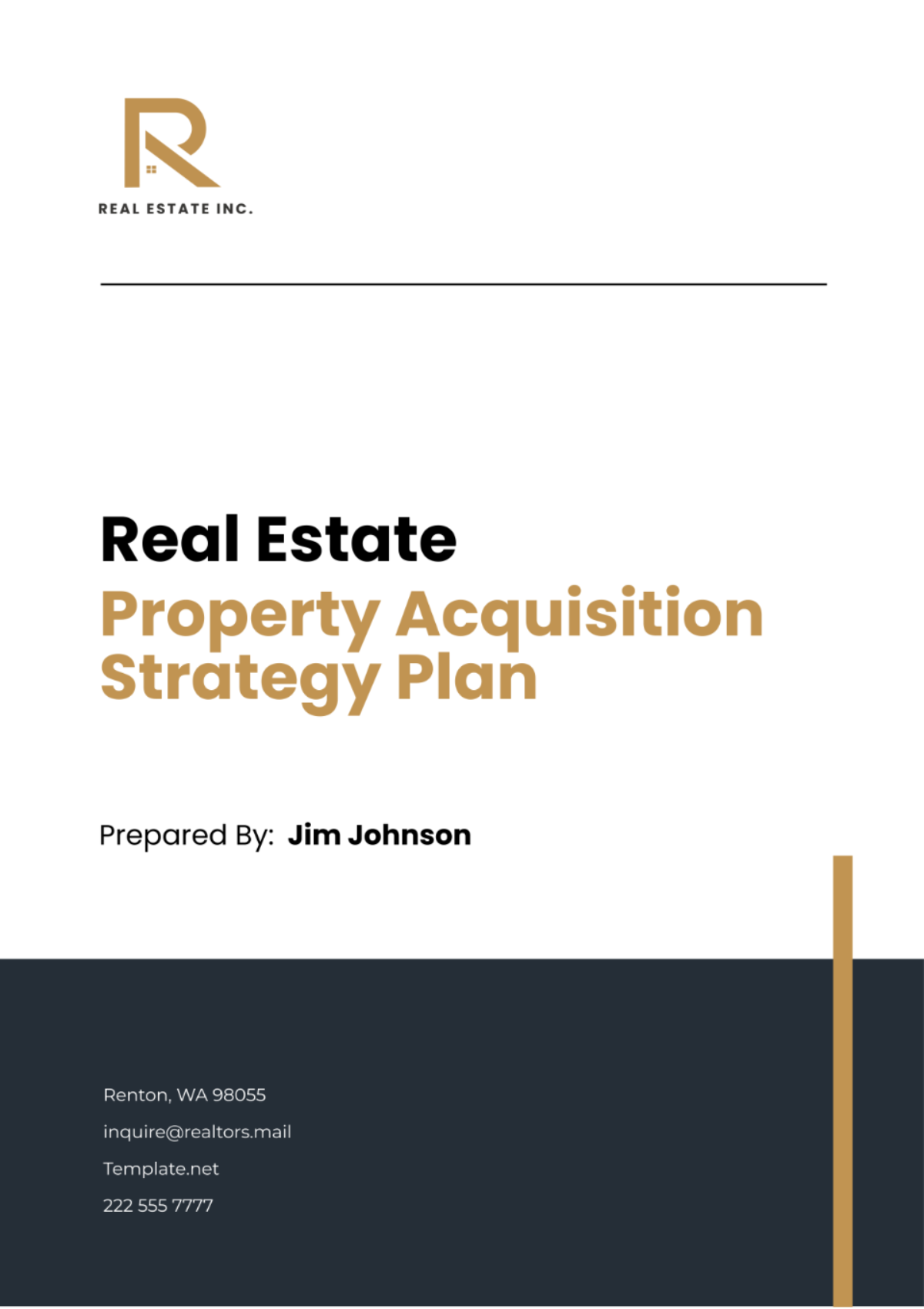
I. Executive Summary
Our Real Estate Property Acquisition Strategy Plan is designed to outline our methodical approach towards identifying, evaluating, and acquiring profitable real estate properties that align with our investment goals. This strategy is built on a foundation of thorough market analysis, precise investment criteria, and robust financial planning, ensuring each property acquired contributes to our portfolio's strength and diversity. By focusing on strategic acquisitions, we aim to optimize returns, enhance asset value, and mitigate investment risks.
Objectives
To expand our real estate portfolio.
To achieve a minimum annual return on investment (ROI) of 8%.
To diversify our investment across various property types and regions.
To implement value-add strategies to increase property value and cash flow.
II. Market Analysis
The current real estate market is characterized by a mix of opportunities and challenges, influenced by economic trends, interest rates, and regional development activities. Our strategic approach involves a deep dive into market dynamics, identifying areas with high growth potential and under-valued properties. By staying ahead of market trends and leveraging data analytics, we position ourselves to capitalize on opportunities that align with our investment objectives.
Target Market
Target Market | Geographic Areas | Reason for Targeting |
Residential: | Suburban Cityville | High demand for family housing, significant appreciation potential |
Commercial: | Downtown Metrotown | Revitalization projects boosting foot traffic, potential for high rental yields |
Industrial: | Near Portside Industrial Park | Growing demand for logistics space due to e-commerce growth |
III. Investment Criteria
Our investment criteria are designed to ensure that all acquisitions align with our strategic goals and financial objectives. This framework guides our property selection process, focusing on potential for appreciation, income generation, and alignment with our portfolio's diversification strategy.
Property Type | Financial Criteria | Size | Location | Condition |
Residential: Single-Family | ROI ≥ 8%, Cash Flow Positive | 1,500 - 3,000 sq ft | Suburban areas, close to schools and amenities | Good to Excellent, minor renovations acceptable |
Commercial: Retail Spaces | Cap Rate ≥ 5%, High foot traffic | 5,000 - 10,000 sq ft | Central business districts, high visibility areas | Moderate to Excellent, ready for tenant fit-outs |
Industrial: Warehouses | ROI ≥ 7%, Long-term leases | 10,000 - 50,000 sq ft | Accessible to major highways and ports | Good to Excellent, with modern logistics facilities |
IV. Sourcing Strategies
A. Identifying Potential Properties
To effectively identify potential properties that meet our investment criteria, we employ a multifaceted approach that combines traditional and innovative methods. This strategy allows us to uncover a broad spectrum of opportunities, from listed to off-market properties, ensuring we never miss out on a potential acquisition that aligns with our objectives.
Multiple Listing Service (MLS): Offers comprehensive access to properties on the market, particularly useful for residential and commercial spaces.
Real Estate Auctions: Provide opportunities to acquire properties at below-market rates, suitable for our commercial and industrial investment segments.
Direct Mail Campaigns: Target specific property owners in our identified geographic areas, especially for acquiring single-family homes and warehouses directly.
Off-Market Deals: Through our network, we identify properties not yet listed for sale, often allowing for better negotiation terms.
B. Networking and Relationships
Building and maintaining strong relationships with key stakeholders in the real estate industry are crucial for our sourcing strategy. These connections provide us with valuable insights and access to off-market deals.
Stakeholder | Role | How They Contribute |
Real Estate Agents | Intermediaries | Offer early access to listings and off-market deals. |
Property Owners | Direct Sellers | Provide opportunities for direct acquisition. |
Investment Groups | Partners and Competitors | Share insights and potential co-investment opportunities. |
Legal and Financial Advisors | Advisory Services | Offer guidance on transactions and financing. |
C. Using Technology and Data Analytics
Leveraging technology and data analytics is a cornerstone of our strategy, enabling us to analyze market trends, identify potential investments, and make informed decisions swiftly. Tools such as property data platforms provide insights into market values, historical data, and predictive analytics, helping us to target properties with the best potential returns. Additionally, customer relationship management (CRM) systems streamline our outreach and follow-up processes with property owners and agents.
V. Evaluation and Due Diligence
A. Assessing Property Value
Once a potential property is identified, we conduct a thorough evaluation to assess its value and potential returns. This process involves analyzing comparable market sales, current and projected income streams, and the property's physical and legal status. Our goal is to ensure that every acquisition meets our strict financial criteria and has potential for value enhancement.
B. Checklist for Due Diligence
The due diligence phase is critical to identifying any issues that could affect the property's value or our ability to achieve the projected returns.
Property inspections (structural, mechanical, electrical)
Legal checks (title, zoning compliance, easements)
Financial analysis (cash flow projections, expense verification)
Environmental assessments
Market analysis (rental rates, occupancy levels)
VI. Financing Strategy
Securing the right financing is essential to the success of each acquisition. We explore a variety of financing options, selecting those that best match the property type and our investment goals.
Financing Option | Criteria |
Bank Loans | Competitive interest rates, favorable terms for long-term investments. |
Private Lenders | Flexibility for short-term financing or when traditional financing is not viable. |
Real Estate Investment Trusts (REITs) | For large-scale commercial or industrial projects, offering equity financing. |
Seller Financing | Directly negotiated with sellers, offering creative terms for acquisition. |
VII. Acquisition Process
A. Initial Offer to Closing
The acquisition process is a structured sequence of steps from the initial offer to the closing of the deal. This process ensures that each acquisition is executed efficiently and aligns with our strategic objectives.
Initial Assessment and Offer: After identifying a potential property, we conduct a preliminary assessment and make an initial offer based on our valuation models.
Negotiation: If the initial offer is met with interest, we enter into negotiation with the seller to reach agreeable terms.
Formal Due Diligence: Upon reaching a tentative agreement, we conduct formal due diligence to thoroughly evaluate the property and identify any potential issues.
Final Offer and Agreement: Based on the due diligence findings, we may adjust our offer and move towards finalizing the purchase agreement.
Closing: The closing process involves the finalization of all legal documents, transfer of funds, and officially transferring the property's ownership.
B. Roles and Responsibilities
Ensuring clarity of roles and responsibilities is crucial for the smooth execution of the acquisition process.
Role | Responsibility |
Acquisition Manager | Oversees the entire acquisition process, from identification to closing. |
Financial Analyst | Conducts financial analysis and due diligence, ensuring the property meets our investment criteria. |
Legal Advisor | Handles all legal aspects, including contract review and compliance checks. |
Property Inspector | Conducts physical inspections of the property to assess its condition. |
C. Timeframes
The timeframe for each acquisition can vary based on a variety of factors, including the complexity of the deal and due diligence findings.
Milestone | Timeline |
Initial Offer | Week 1-2 |
Negotiation | Week 3-4 |
Due Diligence | Week 5-8 |
Final Offer and Agreement | Week 9 |
Closing | Week 10-12 |
VIII. Post-Acquisition Management
A. Strategy for Property Management
Following the acquisition, our strategy for property management focuses on maximizing operational efficiency, tenant satisfaction, and property value. This includes implementing cost-effective property maintenance, proactive tenant engagement practices, and leveraging technology for management operations to ensure high occupancy rates and optimal revenue generation.
B. Value-add Improvements
Our plan for value-add improvements is targeted towards enhancing property appeal, functionality, and efficiency. This may include modernizing facilities, improving energy efficiency, and adding amenities that increase the property’s marketability and rental rates. These improvements are carefully selected based on their potential to generate a significant return on investment.
C. Exit Strategies
Our exit strategies are designed to maximize returns and are determined by the property type, market conditions, and investment objectives.
Sale: Sell the property when market conditions are favorable, and significant appreciation has been achieved.
Refinance: Refinance the property to extract equity while retaining ownership, especially if the property is generating substantial cash flow.
Lease to Own: In certain cases, offering a lease-to-own option to tenants can be a strategic exit for residential properties.
1031 Exchange: Utilize a 1031 exchange to defer capital gains tax by reinvesting the proceeds into another property, continuing to grow our portfolio efficiently.
IX. Risk Management
Effective risk management is essential to safeguarding our investments and ensuring the sustainability of our real estate portfolio. By identifying potential risks early and implementing mitigation strategies, we aim to minimize their impact and protect our assets.
Risk | Likelihood | Impact | Mitigation Strategy |
Market Fluctuations | Medium | High | Diversify property types and locations to spread risk. |
Financing Risks | Low | High | Secure fixed-rate financing and maintain strong lender relationships. |
Tenant Vacancies | Medium | Medium | Implement aggressive marketing and tenant retention programs. |
Regulatory Changes | Medium | Medium | Stay informed on regulatory developments and adapt strategies accordingly. |
Construction Delays | High | High | Employ experienced contractors and include contingency plans in contracts. |
X. Performance Measurement and Reporting
Measuring the performance of our real estate investments is crucial to making informed decisions and communicating effectively with stakeholders.
Metric | Values/Benchmarks |
Return on Investment (ROI) | ≥ 8% annually |
Capitalization Rate | ≥ 5% for commercial properties |
Occupancy Rate | ≥ 95% for residential properties |
Cash Flow | Positive cash flow from operations |
Asset Appreciation | Align with or exceed market trends |
Reporting on these metrics will take place on a quarterly basis, providing stakeholders with a clear and comprehensive view of our portfolio's performance. Additionally, an annual report will be prepared to review the year's achievements, challenges, and strategic adjustments for the future. Reporting will be conducted through secure digital platforms, ensuring timely and efficient dissemination of information. This structured approach to performance measurement and reporting enables us to track our progress towards achieving our investment objectives, make data-driven decisions, and maintain transparency with our investors and partners.
- 100% Customizable, free editor
- Access 1 Million+ Templates, photo’s & graphics
- Download or share as a template
- Click and replace photos, graphics, text, backgrounds
- Resize, crop, AI write & more
- Access advanced editor
Streamline your acquisition process using the Real Estate Property Acquisition Strategy Plan Template from Template.net. Editable and customizable, this template is designed to detail your strategic approach effectively. With the ability to fine-tune every aspect in our AI Editor tool, it sets the stage for a successful property acquisition, ensuring a comprehensive and targeted strategy.
You may also like
- Finance Plan
- Construction Plan
- Sales Plan
- Development Plan
- Career Plan
- Budget Plan
- HR Plan
- Education Plan
- Transition Plan
- Work Plan
- Training Plan
- Communication Plan
- Operation Plan
- Health And Safety Plan
- Strategy Plan
- Professional Development Plan
- Advertising Plan
- Risk Management Plan
- Restaurant Plan
- School Plan
- Nursing Home Patient Care Plan
- Nursing Care Plan
- Plan Event
- Startup Plan
- Social Media Plan
- Staffing Plan
- Annual Plan
- Content Plan
- Payment Plan
- Implementation Plan
- Hotel Plan
- Workout Plan
- Accounting Plan
- Campaign Plan
- Essay Plan
- 30 60 90 Day Plan
- Research Plan
- Recruitment Plan
- 90 Day Plan
- Quarterly Plan
- Emergency Plan
- 5 Year Plan
- Gym Plan
- Personal Plan
- IT and Software Plan
- Treatment Plan
- Real Estate Plan
- Law Firm Plan
- Healthcare Plan
- Improvement Plan
- Media Plan
- 5 Year Business Plan
- Learning Plan
- Marketing Campaign Plan
- Travel Agency Plan
- Cleaning Services Plan
- Interior Design Plan
- Performance Plan
- PR Plan
- Birth Plan
- Life Plan
- SEO Plan
- Disaster Recovery Plan
- Continuity Plan
- Launch Plan
- Legal Plan
- Behavior Plan
- Performance Improvement Plan
- Salon Plan
- Security Plan
- Security Management Plan
- Employee Development Plan
- Quality Plan
- Service Improvement Plan
- Growth Plan
- Incident Response Plan
- Basketball Plan
- Emergency Action Plan
- Product Launch Plan
- Spa Plan
- Employee Training Plan
- Data Analysis Plan
- Employee Action Plan
- Territory Plan
- Audit Plan
- Classroom Plan
- Activity Plan
- Parenting Plan
- Care Plan
- Project Execution Plan
- Exercise Plan
- Internship Plan
- Software Development Plan
- Continuous Improvement Plan
- Leave Plan
- 90 Day Sales Plan
- Advertising Agency Plan
- Employee Transition Plan
- Smart Action Plan
- Workplace Safety Plan
- Behavior Change Plan
- Contingency Plan
- Continuity of Operations Plan
- Health Plan
- Quality Control Plan
- Self Plan
- Sports Development Plan
- Change Management Plan
- Ecommerce Plan
- Personal Financial Plan
- Process Improvement Plan
- 30-60-90 Day Sales Plan
- Crisis Management Plan
- Engagement Plan
- Execution Plan
- Pandemic Plan
- Quality Assurance Plan
- Service Continuity Plan
- Agile Project Plan
- Fundraising Plan
- Job Transition Plan
- Asset Maintenance Plan
- Maintenance Plan
- Software Test Plan
- Staff Training and Development Plan
- 3 Year Plan
- Brand Activation Plan
- Release Plan
- Resource Plan
- Risk Mitigation Plan
- Teacher Plan
- 30 60 90 Day Plan for New Manager
- Food Safety Plan
- Food Truck Plan
- Hiring Plan
- Quality Management Plan
- Wellness Plan
- Behavior Intervention Plan
- Bonus Plan
- Investment Plan
- Maternity Leave Plan
- Pandemic Response Plan
- Succession Planning
- Coaching Plan
- Configuration Management Plan
- Remote Work Plan
- Self Care Plan
- Teaching Plan
- 100-Day Plan
- HACCP Plan
- Student Plan
- Sustainability Plan
- 30 60 90 Day Plan for Interview
- Access Plan
- Site Specific Safety Plan


